Barnsley and District Tramways
History
Barnsley and District Tramways were owned and operated by the Barnsley and District Electric Traction Company, which was a subsidiary of the much larger British Electric Traction Company (BETCo), a concern which at its zenith either owned, part-owned or leased almost 50 tramway concerns across the British Isles.
In the late 1890s, the BETCo was aggressively purchasing horse and steam-operated tramways across the British Isles with the intention of converting them to electric traction, as well as promoting schemes for completely new electric tramways. In 1899, the BETCo gained powers to construct a small standard-gauge tramway system in Barnsley, much to Barnsley Corporation's annoyance, as they had their own plans for a municipal system. The corporation however, soon wavered, eventually opting to support the company's plans; with the first tram running on the 31st October 1902. The system was a mere 3 miles long, running from the Smithies in Monk Bretton to the north of Barnsley, southwestwards, before turning southeastwards towards and through Barnsley, where the line spit in two, southwestwards to Worsborough Bridge and southeastwards to Worsborough Dale.
Passenger numbers were unfortunately disappointing, so one can well understand the company's reluctance to build extensions, despite being pressured to do so by surrounding councils. In 1912, the company decided that petrol-bus operation was a more promising means of expansion, and by the end of 1913, they possessed forty-eight vehicles, a quite staggering number considering that the technology was still largely unproven. The gamble proved to be successful, and in June 1919, the name of the company was changed to the Barnsley and District Traction Company, to emphasise the change in scope. Perhaps surprisingly, in view of the success of the bus operations, the company continued to invest in track renewals in the 1920s.
On the 10th July 1924, the B&DT got a new neighbour in the form of a brand-new tramway, the Dearne District Light Railway, which was owned by Wath-upon-Dearne, Wombwell, Bolton-upon-Dearne and Thurnscoe Urban District Councils. The relationship between the DDLR and the B&DTCo was, however, not a happy one, as the councils had deliberately blocked the expansion plans of the latter, driven by a desire for a publicly owned service; as a result, the B&DTCo refused to countenance a connection between the two systems, despite the tracks being only a few feet apart. The B&DTCo's buses were of course now in direct competition with the DDLR's trams, and the latter's inability to gain access to Barnsley was to prove fatal. In fact, the DDLR proved to be a titanic waste of ratepayers' money, and was to last only nine years before it was closed.
In November 1928 (or possibly January 1929; documentary sources are conflicting), the company's name was changed yet again, this time to the Yorkshire Traction Company, following which it quickly made plans to abandon the tramway system. The last tram of all ran on the 1st September 1930.
Uniforms
Unfortunately, despite the fact that the company operated for some twenty-eight years, photographs depicting staff are not only surprisingly rare, but are overwhelmingly from the first decade and a half of operation; care must therefore be exercised in extrapolating from this evidence through the Great War and the 1920s, as uniforms may well have changed in style over the course of these circa fifteen years. The photographs that have survived do, however, show staff of the B&DTCo wearing the familiar and largely regulation BETCo uniform; although jackets varied somewhat between BETCo systems, as well as across the decades, the cap badges, collar designations and buttons invariably followed a standard pattern.
Tramcar crews were initially provided with double-breasted jackets with lapels and five pairs of brass buttons (of the standard BETCo pattern — see link), the collars of which probably bore embroidered block-capital system initials ('B & D E T' ). The tensioned-crown peaked caps bore the standard BETCo ‘Magnet & Wheel’ device badge (see below), along with an employee number (in individual brass numerals), worn below.
This first style of uniform jacket was quickly displaced by a single-breasted design with five buttons (presumably of the standard BETCo pattern — see link), a single breast pocket (with button closure) and stand-up collars; the latter carried an employee number on the bearer's left-hand side (in individual numerals) and systems initials ('B & D E T') in individual letters on the right-hand side, all almost certainly in brass. At some point prior to 1912, the system initials on the collars were reduced to 'B & D T'.
Inspectors wore single-breasted jackets, edged in a finer material than the main body, with hidden buttons (or more likely hook and eye fasteners) and stand-up collars, the latter bearing the grade — 'Inspector' — in embroidered script lettering. The tensioned-crown peaked caps also bore the grade in embroidered script lettering, but on a hat band, above which the standard BETCo 'Magnet & Wheel' device badge was mounted. The chief inspector wore a virtually identical uniform, but with the grade 'Chief Inspector'; this was embroidered on the jacket collars and on a brocade-style hat band on the cap. Senior staff were also provided with smart double-breasted overcoats with lapels, the collars of which bore the grade in embroidered script lettering.
Like the vast majority of UK tramway systems, female staff were employed in significant numbers during the Great War to replace male staff lost to the armed services. A studio portrait has survived that depicts eight conductresses, all wearing long, tailored, single-breasted coats bearing five buttons, a waist belt (with two-buttons), epaulettes, cuff embellishments, and high, fold-over collars; the latter carried system initials ('B & D T') on the bearer's left-hand side and an employee number on the right-hand side. The collar insignia came in two distinct forms, smooth brass and striated brass, the latter giving a rope-like effect; the smooth badges were in fact used by the vast majority of BETCo tramways, whereas the striated badges appear to have been used by only a small minority of systems. It is currently unclear whether jackets were worn underneath the long coats or not. Headgear took the form of a cloth bonnet with an upturned brim, around which was a thick material band, held in place by a wide cloth loop at the front; the standard BETCo 'Magnet & Wheel' device badge was mounted on the loop (see below). As far as I am aware, this unusual design of hat was unique to this system.
The tramway company also employed women as inspectors during the Great War. Inspectresses were issued with full-length, single-breasted coats with high, fold-over collars and a buckle-fastened waist belt, all in a gabardine-like material. The collars bore the grade — 'Inspector' — in embroidered script lettering. Inspectresses hats were identical in form to those worn by conductresses, but seemingly made from the same gabardine-like material as their full-length coats; the bonnet bore the standard BETCo 'Magnet & Wheel' device badge. It is unclear whether inspectresses wore a company-issued jacket underneath this top coat.
Further reading
For more information on the Barnsley and District Tramways, see: 'A History of the Barnsley, Dearne, Mexborough and Rotherham Tramway Conurbation' by C C Hall, in the Tramway Review, Nos 53 (p99-118), 54 (p123-135), 55 (p147-168), 56 (p171-183), 57 (p195-207) and 58 (p27-39); The Light Railway Transport League (1968-1969).
Images
Motormen and conductors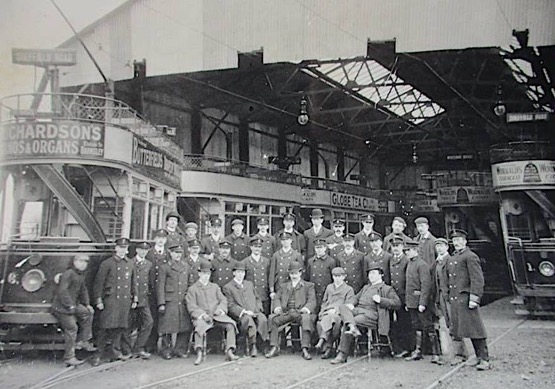
A photograph taken at Sheffield Road depot, which judging by the pristine condition of the trams, was probably taken in 1902. Unfortunately, the image is of too poor a quality to make out any of the uniform details, though the men without greatcoats are certainly wearing double-breasted jackets with lapels. Photo courtesy of the Craig Sheppard Collection.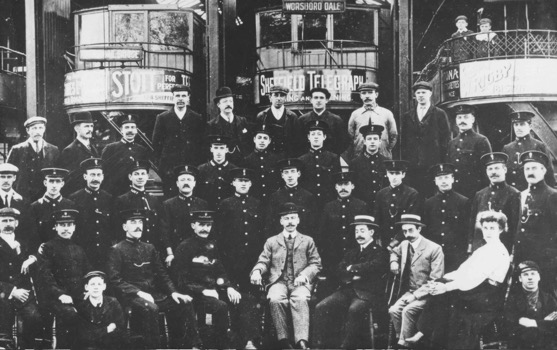
Another staff photo taken at the depot, purportedly in 1908. Author's Collection.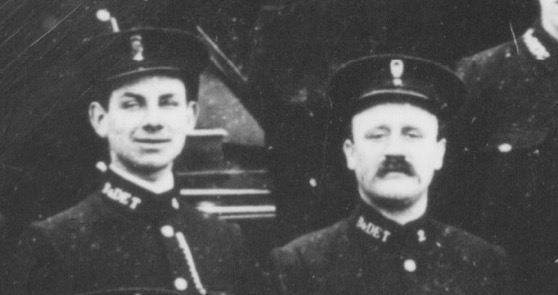
An enlargement of the above photograph showing two of the tramcar staff, Employees No 4 (left) and No 2 (right). Their left-hand collars bear their employee numbers, their right-hand collars system initials, 'B & D E T'. Their tensioned-crown peaked caps bear the standard BETCo 'Magnet & Wheel' device badge, worn above an employee number.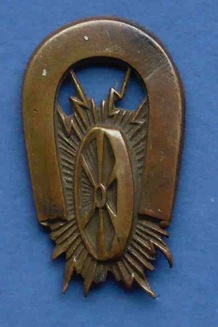
Standard British Electric Traction Company ‘Magnet & Wheel’ cap badge, of the type worn by Barnsley and District Tramways staff — brass. Author's Collection.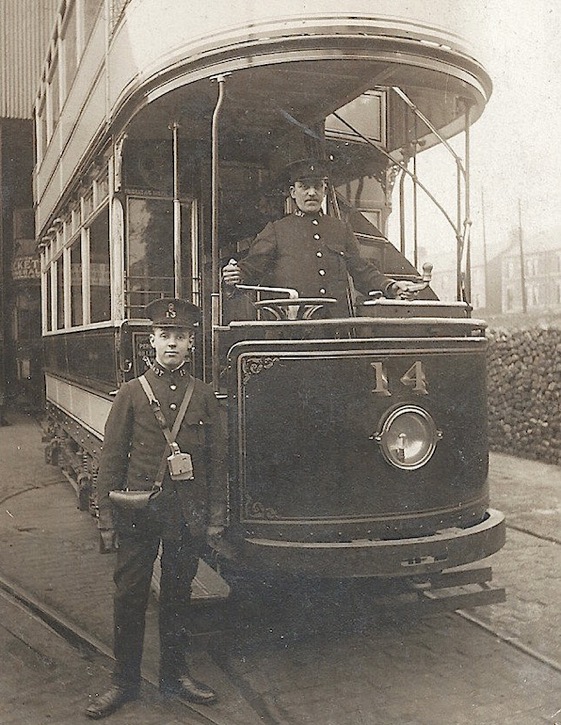
A conductor (Employee No 13) and a motorman (probably Employee No 2, the same man as in the previous photo) with a rather new-looking Tramcar No 14, suggesting that the photograph was taken in or shortly after 1912, when this tramcar was delivered. Although both men have an employee number on their left-hand collars, their right-hand collars now bear system initials lacking the 'E', i.e., 'B & D T'.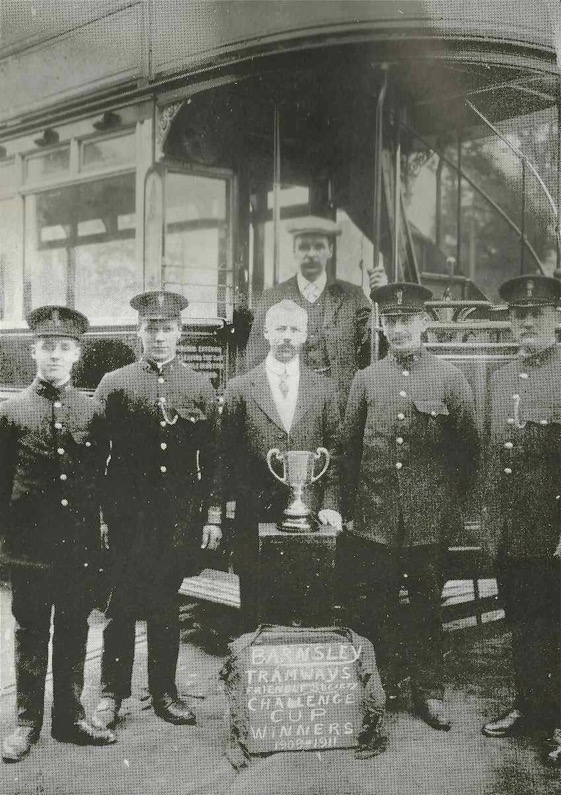
A poor quality photograph, but one which shows four B&DTCo tramcar staff proudly posing for the camera with the Friendly Society Challenge Cup, presumably in 1911. All are wearing single-breasted jackets and caps bearing standard brass BETCo insignia. The jacket collars carry an employee number on the left-hand side and individual 'B & D T' initials on the right-hand side. Photo courtesy of the Stephen Howarth Collection.
Senior staff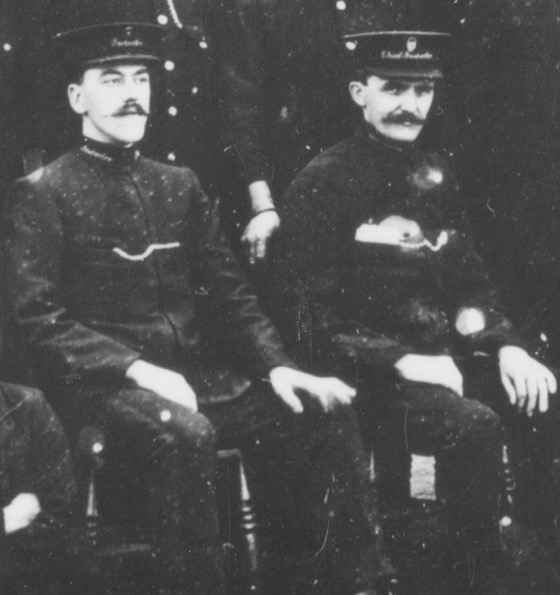
An enlargement of the 1908 staff photograph above showing an inspector (left) and the Chief Inspector (right). Both men's grades appear on their jacket collars and on their tensioned-crown peaked caps.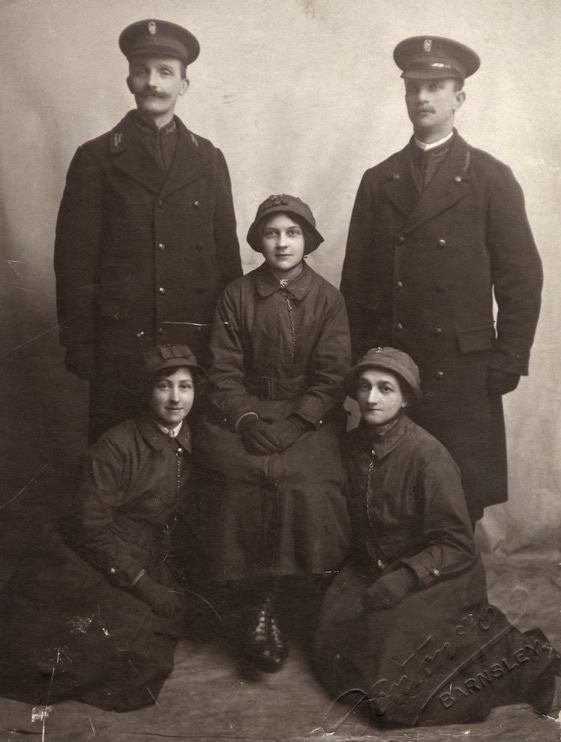
A rare portrait of three B&DT inspectresses, an inspector (back right) and the Chief Inspector (back left) — photo undated, but almost certainly taken during or shortly after the Great War. Author's Collection.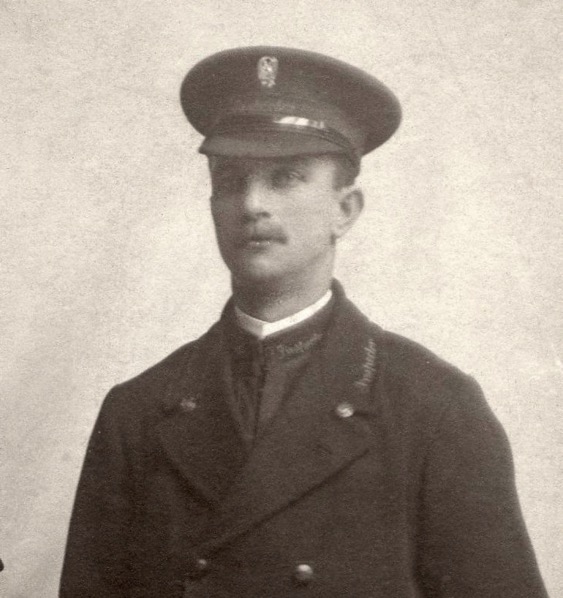
An enlargement of the above photograph showing the inspector. His single-breasted jacket, which has stand-up collars, can just be made out underneath his overcoat; the collars, along with those on his overcoat, bear his grade — 'Inspector' — in embroidered script lettering. His cap also bears his grade in embroidered script lettering, along with the standard BETCo 'Magnet & Wheel' cap badge.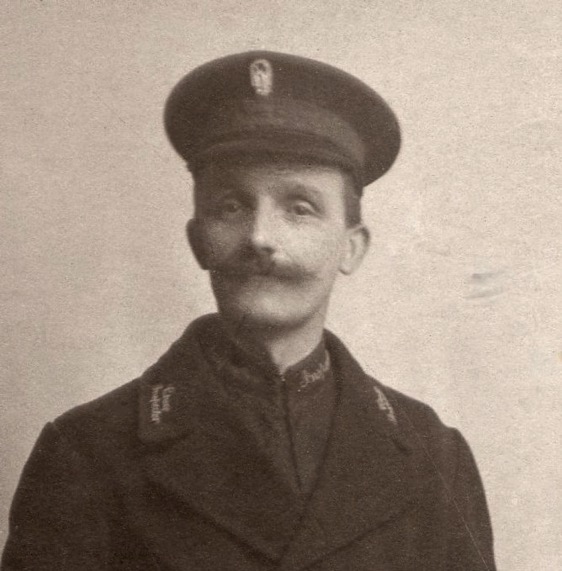
A further enlargement of the above photograph, this time showing the Chief Inspector, who would appear to be the same man as in the 1908 staff photograph above. His uniform, overcoat and cap insignia all appear to be identical to the inspector's, save for the grade, though possibly with a more elaborate hat band.
Female staff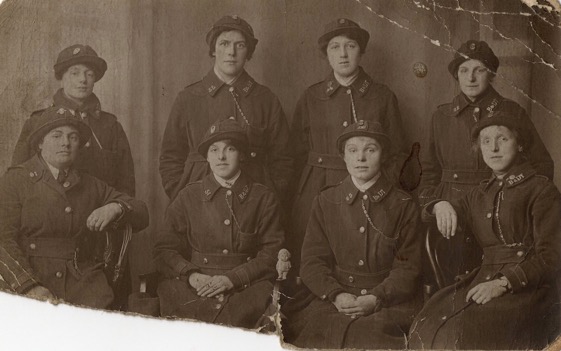
A group of eight Great War B&DT female staff, probably all conductresses. The bonnets are really quite unusual, and as far as I am aware, were unique to the B&DT amongst UK tramway systems. Author's Collection.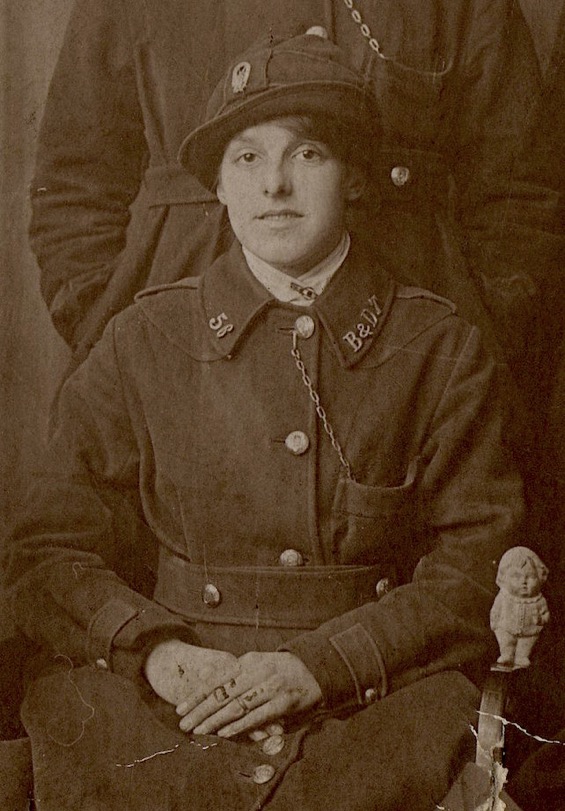
An enlargement of the above photograph showing Employee No 56. Like most of the others depicted, she is wearing narrow system initials, which were striated to give a rope-like effect; this type of badge also found use on a small number of other BETCo systems.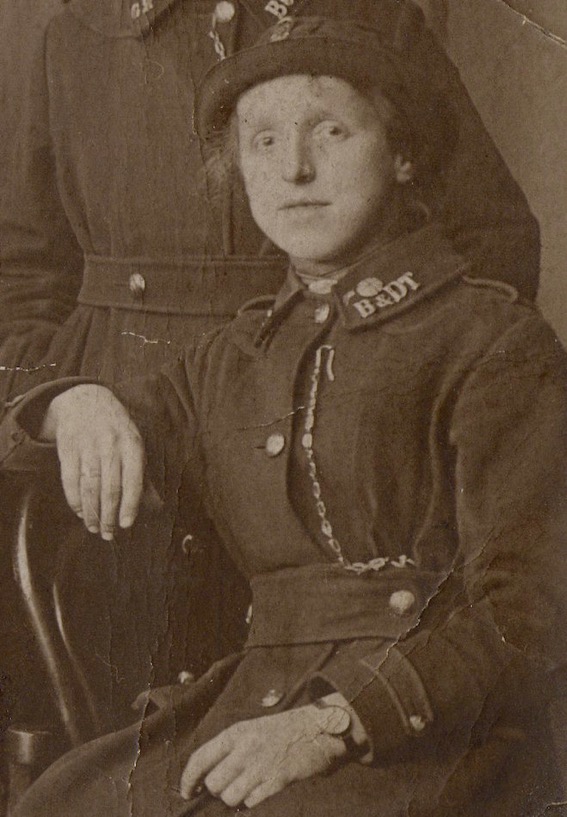
Another blow-up of the above photograph, this time showing one of the conductresses with the more usual smooth brass collar insignia.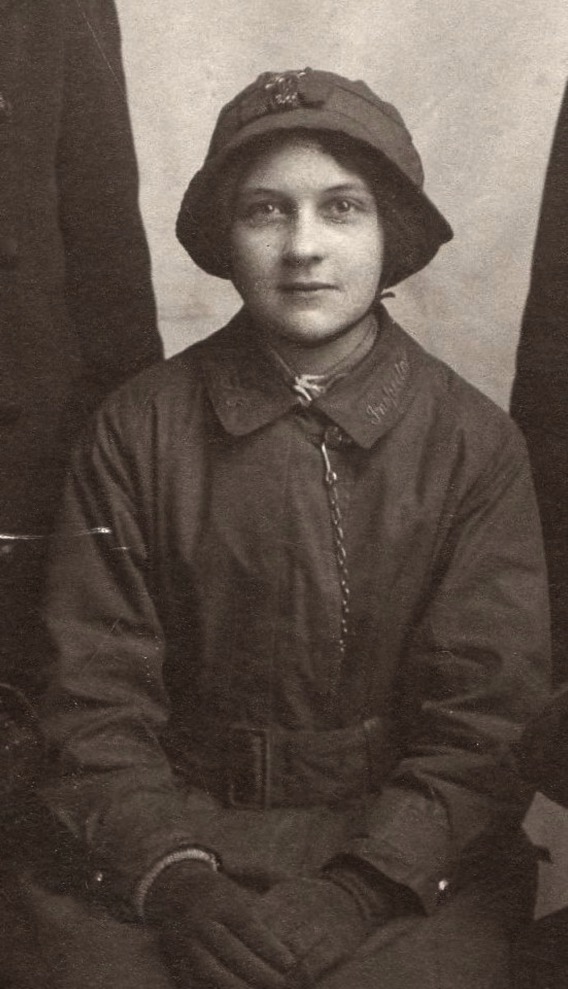
An enlargement of the 'inspectors' studio photograph above showing a Great War B&DT inspectress. She is wearing a full-length, single-breasted coat with high, fold-over collars (bearing her grade) and a waist belt, all in a gabardine-like material. The style of bonnet is very similar to those worn by conductresses, but probably in the same material as the coat; it bears the standard BETCo 'Magnet & Wheel' device badge.